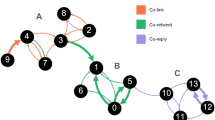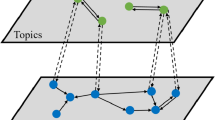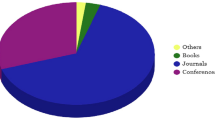Abstract
Online Social Networks (OSNs) have become inevitable for any new methodology both for viral promoting applications and instructing the creation of inciting information and data. As a result, finding influential users in OSNs is one of the most studied research problems. Existing research works paid less attention to the temporal factors associated with the activities performed by the social users. Our motivation is to find influential users who show their most powerful interests towards a given query on various subjects (topics) at different time intervals by featuring more on users’ most recent activities as well as their associations with different users. To address this problem, we propose a temporal activity-biased weight model that gives higher weight to users’ recent activities and develops an algorithm to list the most effective influential users. In addition, our proposed model also considers the impacts of topical similarities both from direct and indirect neighbors of the users. Experimental results on two real datasets demonstrate that our proposed framework yields better outcomes than the baseline method.














Similar content being viewed by others
Code Availability
The code implemented in this paper is described in Sections 3.2.3 and 3.2.3. Detailed code can be found in https://github.com/ron352/Trending-TIUD.
References
Abu-Salih B, Chan KY, Al-Kadi O, Al-Tawil M, Wongthongtham P, Issa T, Saadeh H, Al-Hassan M, Bremie B, Albahlal A (2020) Time-aware domain-based social influence prediction. J Big Data 7(1):10
Al-garadi MA, Varathan KD, Ravana SD (2017) Identification of influential spreaders in online social networks using interaction weighted k-core decomposition method. Physica A: Statistical Mechanics and its Applications 468:278–288
Alp ZZ, Öğüdücü ŞG (2018) Identifying topical influencers on twitter based on user behavior and network topology. Knowl-Based Syst 141:211–221
Alshahrani M, Fuxi Z, Sameh A, Mekouar S, Huang S (2020) Efficient algorithms based on centrality measures for identification of top-k influential users in social networks. Inf Sci 527:88–107
Antonakaki D, Fragopoulou P, Ioannidis S (2021) A survey of twitter research: Data model, graph structure, sentiment analysis and attacks. Expert Syst Appl 164:114006
Anuar NIM, Mohamad SR, Zulkiffli WFW, Hashim NAAN, Abdullah AR, Rasdi ALM, Hasan H, Abdullah T, Deraman SNS, Zainuddin SA et al (2020) Impact of social media influencer on instagram user purchase intention towards the fashion products: The perspectives of students. European Journal of Molecular & Clinical Medicine 7(8):2589–2598
Anwar MM (2020) Query-oriented temporal active intimate community search. In: Australasian database conference. Springer, pp 206–215
Anwar MM, Liu C, Li J (2019) Discovering and tracking query oriented active online social groups in dynamic information network. World Wide Web 22(4):1819–1854
Aurpa TT, Khan F, Anwar MM (2020) Discovering and tracking query oriented topical clusters in online social networks. In: 2020 IEEE Region 10 symposium (TENSYMP). IEEE, pp 1054–1057
Statistics and twitter (2020) https://www.b2bmarketingzone.com/statistics/twitter/
Belhadi A, Djenouri Y, Lin JCW, Cano A (2020) A data-driven approach for twitter hashtag recommendation. IEEE Access 8:79182–79191. https://doi.org/10.1109/ACCESS.2020.2990799
Blei DM, Ng AY, Jordan MI (2003) Latent dirichlet allocation. The Journal of machine Learning research 3:993–1022
Brin S, Page L (1998) The anatomy of a large-scale hypertextual web search engine. Computer Networks and ISDN Systems 30(1-7):107–117
Choudhery D, Leung CK (2017) Social media mining: prediction of box office revenue. In: Proceedings of the 21st international database engineering & applications symposium, pp 20–29
Das BC, Anwar MM, Bhuiyan MAA, Sarker IH, Alyami SA, Moni MA (2021) Attribute driven temporal active online community search. IEEE Access 9:93976–93989
Dencik L, Hintz A, Carey Z (2018) Prediction, pre-emption and limits to dissent: Social media and big data uses for policing protests in the united kingdom. New Media & Society 20(4):1433–1450
Dewan A (2021) Detecting organic audience involvement on social media platforms for better influencer marketing and trust-based e-commerce experience. In: Data analytics and management, pp. 661–673. Springer
Dhali A, Gomasta SS, Mohanta S, Anwar MM (2020) Identification of query-oriented influential users in online social platform. In: 2020 IEEE Region 10 symposium (TENSYMP). IEEE, pp 973–976
Feng Y, Chen H, Kong Q (2020) An expert with whom i can identify: the role of narratives in influencer marketing. Int J Advert, 1–22
Han B, Cook P, Baldwin T (2013) Lexical normalization for social media text. ACM Transactions on Intelligent Systems and Technology (TIST) 4(1):1–27
Haveliwala TH (2002) Topic-sensitive pagera7frfdddikznk, 2002. In: Proceedings of the 11th association for computing machinery international conference on world wide web (ACM), pp 517– 526
36 twitter statistics all marketers should know in 2021 (2021). https://blog.hootsuite.com/twitter-statistics/
Javed Awan M, Mohd Rahim MS, Nobanee H, Munawar A, Yasin A, Zain AM (2021) Social media and stock market prediction: a big data approach
Jianqiang Z, Xiaolin G, Feng T (2017) A new method of identifying influential users in the micro-blog networks. IEEE Access 5:3008–3015. https://doi.org/10.1109/ACCESS.2017.2672680
Kemp S (2021) Digital 2020: July global statshot - datareportal – global digital insights. https://datareportal.com/reports/digital-2020-july-global-statshot
Kumar S, Singhla L, Jindal K, Grover K, Panda B (2021) Im-elpr: Influence maximization in social networks using label propagation based community structure. Appl Intell, 1–19
Leskovec J, Krevl A (2014) Snap datasets: Stanford large network dataset collection
Li H, Zhang R, Zhao Z, Liu X, Yuan Y (2021) Identification of top-k influential nodes based on discrete crow search algorithm optimization for influence maximization. Appl Intell, 1–17
Li Y, Li R, Xiong X, Gu X, Liang T, Xu M, Yuan Y (2021) Multi-topical authority sensitive influence maximization with authority based graph pruning and three-stage heuristic optimization. Appl Intell, 1–19
Lin Y (2021) 10 twitter statistics every marketer should know in 2021 [infographic]. https://www.oberlo.com/blog/twitter-statistics
Mandal S, Maiti A (2021) Deep collaborative filtering with social promoter score-based user-item interaction: a new perspective in recommendation. Appl Intell, 1–26
McPherson M, Smith-Lovin L, Cook JM (2001) Birds of a feather: Homophily in social networks. Annual Review of Sociology 27(1):415–444
Mittal D, Suthar P, Patil M, Pranaya P, Rana DP, Tidke B (2020) Social network influencer rank recommender using diverse features from topical graph. Procedia Computer Science 167:1861–1871
Othman J, Vanathas C (2017) Topic familiarity and its influence on listening comprehension. The English Teacher, 14
Pick M (2020) Psychological ownership in social media influencer marketing. European Business Review
Sasaki K, Yoshikawa T, Furuhashi T (2014) Online topic model for twitter considering dynamics of user interests and topic trends. In: Proceedings of the 2014 conference on empirical methods in natural language processing (EMNLP), pp 1977–1985
Sekulić I, Strube M (2020) Adapting deep learning methods for mental health prediction on social media. arXiv:2003.07634
Shi T, Ding S, Xu X, Ding L (2021) A community detection algorithm based on quasi-laplacian centrality peaks clustering. Appl Intell, 1–16
Subroto A, Apriyana A (2019) Cyber risk prediction through social media big data analytics and statistical machine learning. J Big Data 6(1):1–19
Tang J, Zhang J, Yao L, Li J, Zhang L, Su Z (2008) Arnetminer: extraction and mining of academic social networks. In: Proceedings of the 14th ACM SIGKDD international conference on Knowledge discovery and data mining, pp 990–998
Tankovska H (2021) Twitter: monthly active users worldwide. https://www.statista.com/statistics/282087/number-of-monthly-active-twitter-users/
Wang F, Li J, Jiang W, Wang G (2017) Temporal topic-based multi-dimensional social influence evaluation in online social networks. Wirel Pers Commun 95(3):2143–2171
Wang N, Luo F, Shivtare Y, Badal VD, Subbalakshmi K, Chandramouli R, Lee E (2021) Learning models for suicide prediction from social media posts. arXiv:2105.03315
Weng J, Lim EP, Jiang J, He Q (2010) Twitterrank: finding topic-sensitive influential twitterers. In: Proceedings of the third ACM international conference on Web search and data mining, pp 261–270
40 twitter statistics marketers need to know in (2020). https://www.wordstream.com/blog/ws/2020/04/14/twitter-statistics
Zareie A, Sheikhahmadi A, Jalili M (2019) Identification of influential users in social networks based on users’ interest. Inf Sci 493:217–231
Zhang J, Tang J, Li J, Liu Y, Xing C (2015) Who influenced you? predicting retweet via social influence locality. ACM Transactions on Knowledge Discovery from Data (TKDD) 9(3):1–26
Zhao WX, Jiang J, Weng J, He J, Lim EP, Yan H, Li X (2011) Comparing twitter and traditional media using topic models. In: European conference on information retrieval. Springer, pp 338–349
Zheng C, Zhang Q, Young S, Wang W (2020) On-demand influencer discovery on social media. In: Proceedings of the 29th ACM international conference on information & knowledge management, pp 2337–2340
Author information
Authors and Affiliations
Corresponding author
Additional information
Availability of data and material
The data that support the findings of this study are openly available in [27] and [40].
Publisher’s note
Springer Nature remains neutral with regard to jurisdictional claims in published maps and institutional affiliations.
This article belongs to the Topical Collection: Big Data-Driven Large-Scale Group Decision Making Under Uncertainty
Appendix
Appendix
In our proposed framework, we have used multiple mathematical parameters to calculate equations. All the parameters are listed in Table 11.
Rights and permissions
About this article
Cite this article
Gomasta, S.S., Dhali, A., Anwar, M.M. et al. Query-oriented topical influential users detection for top-k trending topics in twitter. Appl Intell 52, 13415–13434 (2022). https://doi.org/10.1007/s10489-022-03582-5
Accepted:
Published:
Issue Date:
DOI: https://doi.org/10.1007/s10489-022-03582-5




